Composite manufacturers commonly use recycled wood in their products, as this is what makes them composites, and not solid plastic.
Most use hardwoods, such as “oak”, “maple”, etc., which are notorious for supporting common mold growth due to the structural cellulose being denser with tannin’s.
Composite manufacturers didn’t generally clean the recycled wood fibers of tannin’s, to eliminate what is known as “tannin bleeding” in the composite decking industry, prior to making composite decking & fencing products.
Failure to clean dirty recycled plastics & wood tannin’s can result in molds feeding on the wood fiber tannin’s when the fungi receive moisture, such as humidity, rain, morning dew or snow. This generally results in the perfect environment for these molds & other fungi to feed & thrive, especially in humid warm sunlight! Composites made from virgin plastic & recycled wood, mold growth from within composite boards is less common, but still can occur if mold or resilient spores exist, before being extruded into composites. This explains why some composite owners have initially experienced molds growing “IN” only one composite board, & none surrounding it, while making others the perfect environment for fungi to feed & spread.
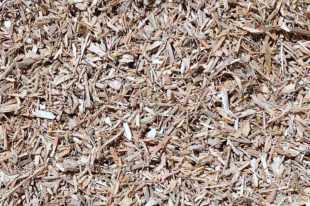
Recycled hardwood fibers commonly mixed with plastic to make composites.
Composite manufacturer extruder’s can’t generally get hot enough to kill or sterilize extremely resilient fungi spores. The plastic & wood generally catches fire first. It is our understanding that heating the wood & plastic, in an attempt to sterilize these materials, to eliminate fungus problems from within, while extruding these materials into products, has burned down at least one composite manufacturing plant.
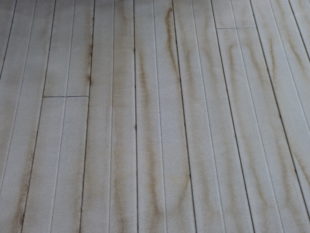
Tannin bleeding from the wood of which this TimberTech® composite deck is made.
Sodium hypochlorite-based products don’t generally clean the wood, from which most composites are partially made, of tannins, to eliminate “tannin bleeding”. They generally chlorine bleach out the redwood, cedar, teak, mahogany, etc. tannin colors, or the natural beauty from solid wood while destroying the wood lignin, or natural glue that holds the cellulose together, which is why some sodium hypochlorite-based products have specific dilution guides for wood or do not recommend the products they manufacture come into contact with wood at all, but only vinyl. Wood deck owners generally wish to restore these beautiful tannin pigments, not chlorine bleach their color.
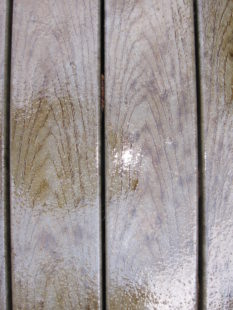
Corte-Clean® cleaning mold stains & tannins from the oak hardwood fiber & recycled PE plastic of which this Lowe’s® ChoiceDek® is made. Failure to thoroughly Corte-Clean® composites, to eliminate mold & other fungus stains, & tannin bleeding, generally results in mold stains re-occurring sooner, rather than later. Do not cut corners, by ignoring all Corte-Clean® product label directions, or you are likely wasting your time & money with this serious industry-wide known cleaning problem.
Once the wood has been chlorine bleached, chemical manufacturers & retailers generally recommend & sell a “wood brightener”, which contains “oxalic acid”, which at least one product claims to “Neutralize and brighten surfaces that have been stripped with corrosive strippers”, such as those products that contain sodium hypochlorite. Therefore, oxalic acid-based cleaning products that restore bleached tannin pigments, or brighten them, & do not remove them, to eliminate tannin bleeding, generally do the exact opposite of what is necessary to clean composites of the underlying issues which can feed mold & other fungi. Using an oxalic acid based product, should not be used in an attempt to clean composites of wood “tannin bleeding” unless one generally wishes to accomplish the exact opposite of what is generally necessary to keep composites clean.
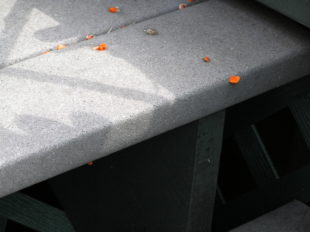
Trex® growing other fungi within weeks of being cleaned with sodium hypochlorite & oxalic acid where the tannin bleeding issue was not properly cleaned.
Composite cleaning issues, specifically those caused by molds, generally due to neglect or improper cleaning chemical product recommendations, is a serious industry wide known problem. Unfortunately, many composite owners have experienced rapidly re-occurring mold & other fungi because of poor cleaning chemical recommendations & use, which has tarnished the overall reputation of the composite decking industry. Most continue to ignore these facts?
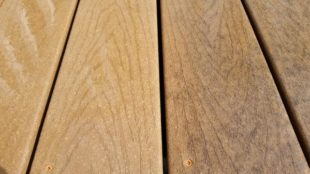
Corte-Clean® working to clean tannins & mold stains from this Trex® deck (left 2 deck boards). Look carefully, you can still see Corte-Clean® turning dirty, discolored or yellow as it is cleaning the mold stains & tannins from the wood fibers that this composite deck is partially made.







